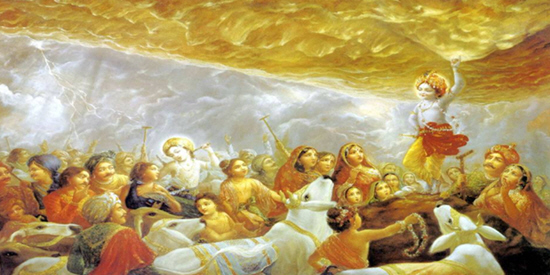
Vajranabha, Lord Krishna’s great-grandson, installed this Deity 5,000 years ago. The same Deity (known then as Gopal) was worshiped by MadhavendraPuri in Vrindavan. Rana Raj Singh of Mewar brought Sri Nathji to Nathdwar around 1669.
The story of how Gopalji was discovered is described in the Caitanya Caritamrita. It was MadhvendraPuri who came to Govardhan Hill and, after he went around the hill and began preparing for the evening rest near GovindaKund, a local cowherd boy visited him with a pot of milk. The beautiful boy made Srila Madhavendra Puri forget his hunger and thirst. MadhavendraPuri asked the boy how he knew he was fasting, and the boy replied that he resided in this vil¬lage and in his village no one fasts.
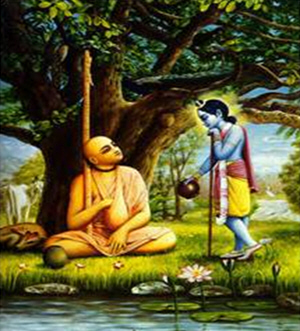
That night in a dream the boy lead Madhavendra to a bush and explained that he was in the bush and suffered from severe cold, heat, rain, and wind. So Madhavendra was thus instructed to find the deity with the help of the local villagers. Gopalaji had been hidden in the bushes and was discovered by Madhavendra Puri.
After the deity’s installation, a structure was made for Him on top of Govardhan Hill. The deity of Gopalaji stands with His left arm raised in the air in the pose Krishna took when He lifted Govardhan Hill as an umbrella to protect the local residents from the fierce rains sent by the demigod Indra.
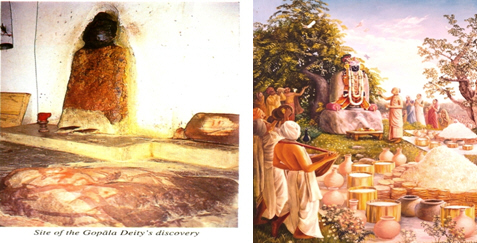
Many people came to the place, named Jatipura (meaning “the home of the Yati or jati –the Sanyasi monk” in reference to Madhavendra Puri), to see and worship Gopalaji. Then a member of the royal family constructed a temple for the deity. After some time, the deity appeared in a dream and ordered Madhavendra to go to JagannathaPuri to get sandalwood, which could be used to cool the deity who was still feeling hot from being in the ground for so many years. So Madhavendra left Jatipura to perform this service.
When Madhavendra arrived in Remuna, north of JagannathaPuri, he stopped at the temple of Gopinatha. Here the priests offer a thick sweet milk preparation (Amritakeli) to the deity. Madhavendra wanted to try some to understand how to prepare it so he could make it to offer his own deity in Vrindavan. Because of his desire to taste the food that was offered to the deity, he felt that he was a great offender and left the temple. That night the deity spoke to the temple priest in a dream and explained that He had hidden a cup of sweet rice behind His dress, and the priest should get it and find MadhavendraPuri to give it to him. The priest then went and found the cup of sweet rice behind the deity’s dress. Tak¬ing the cup, the priest went and called out for Madhavendra until he found him. Madhavendra became spiritually ecstatic to receive the prasadam. After that, the deity in Remuna became known as Ksira-chora-Gopinatha, or Gopinatha who stole the sweet rice.
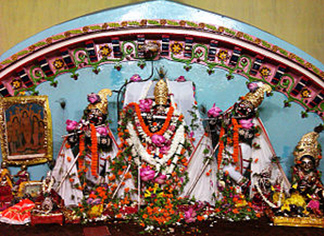
After this Madhavendra went to Jagannatha Puri and got about eight pounds of san¬dalwood and some camphor for his deity in Jatipura. On his way back, he again stopped to see Gopinatha at Remuna. That night his deity,Gopalaji, appeared to him in a dream and explained that there was no difference between His body and the body of Gopinatha in Remuna. Therefore, smearing the sandalwood on the body of Gopinatha would be the same as smearing it on the body of Gopalaji and His body would be cooled. So Madhav¬endra did this every day until all the sandalwood and camphor was finished. A few months later MadhavendraPuri left this world and his samadhi tomb is located in Remuna a few minutes away from the Ksira-cora-Gopinatha temple.
After the disappearance of MadhavendraPuri from this world, the worship of Lord Gopalaji at Jatipura was taken over by Srila Vallabhacarya, who had been initiated in the disciplic succession coming from Sri Vishnuswami. It was during this time that Gopalaji started being called Sri Nathji by the devotees.
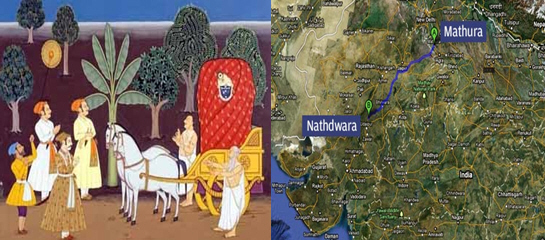
As with otherdeities who were moved from Vrindavana to escape the fanatic Muslim Aurangzeb’s destruction of Hindu temples, Lord Sri Nathji was moved to the land of Mewar from Jatipura. The deity was first moved to Agra where the devotees kept Him in secret for six months, and then moved Him farther west. As the deity was being moved, He reached the spot at village Sihad or Sinhad, the wheels of bullock cart in which the deity was being transported sank axle-deep in mud and could not be moved any farther. The accompanying priests realized that the particular place was the Lord’s chosen spot and accordingly, a temple was built there under the rule and protection of the then Maharana Sri Raj Singh. This is the place that later developed into the village of Nathdwara.
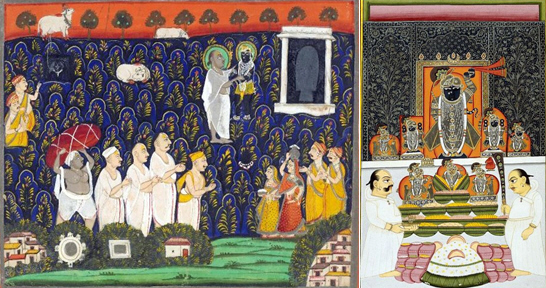
The followers of Pushtimarg assert that the deity’s arm and face first emerged out of the Govardhan hill, and thereafter, the local inhabitants (Vrajavasis) under the spiritual leadership of Madhavendra Puri started the worship of the Gopal (Krishna) deity. This Gopala deity was later termed as Shrinathji. Thus, Madhavendra Puri is attributed to discovery of the deity of Gopal near Govardhana, which was later adapted and worshiped by Vallabhacharya as Shrinathji. Initially, Madhavendra Puri, carried out the worship of the deity’s upraised arm and later, the face. Shrinathji was originally worshipped in a humble shrine at Jatipur village near Govardhan and subsequently, moved to a larger temple on top of the hill. According to Pushtimarg literature, Shrinathji appeared to Shri Vallabhacharya, in the Hindu Vikram Samvat year 1549 and directed Vallabhacharya to proceed to the Govardhan Hill to begin worship. Vallabhacharya made arrangements for the worship of this deity, and this tradition was carried forward by his son, Vitthalnathji.